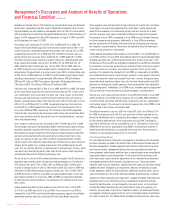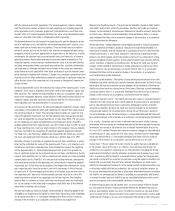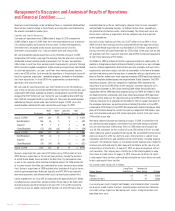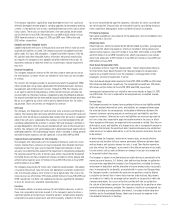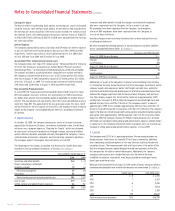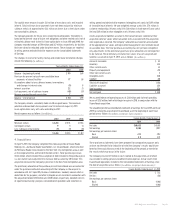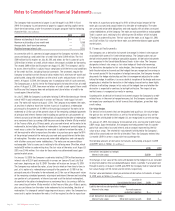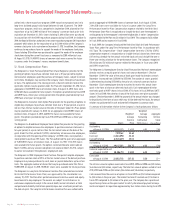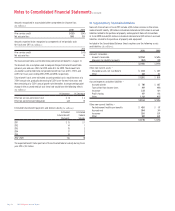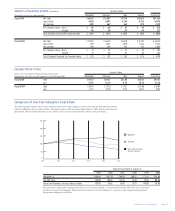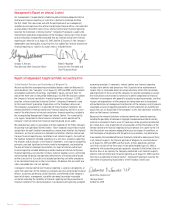Walgreens 2010 Annual Report Download - page 32
Download and view the complete annual report
Please find page 32 of the 2010 Walgreens annual report below. You can navigate through the pages in the report by either clicking on the pages listed below, or by using the keyword search tool below to find specific information within the annual report.
Notes to Consolidated Financial Statements (continued)
Earnings Per Share
The dilutive effect of outstanding stock options on earnings per share is calculated
using the treasury stock method. Stock options are anti-dilutive and excluded from
the earnings per share calculation if the exercise price exceeds the market price of
the common shares. Outstanding options to purchase common shares of 30,661,551
in 2010, 44,877,558 in 2009 and 12,962,745 in 2008 were excluded from the earnings
per share calculations.
Interest Expense
The Company capitalized $12 million, $16 million and $19 million of interest expense
as part of significant construction projects during fiscal 2010, 2009 and 2008,
respectively. Interest paid, which is net of capitalized interest, was $89 million
in fiscal 2010 and fiscal 2009 and $11 million in fiscal 2008.
Accumulated Other Comprehensive Income (Loss)
The Company follows ASC Topic 715, Compensation — Retirement Benefits (Formerly
SFAS No. 158, Employers’ Accounting for Defined Benefit Pension and Other
Postretirement Plans — an Amendment of FASB Statements No. 87, 88, 106 and 132(R)).
The amount included in accumulated other comprehensive income related to
the Company’s postretirement plan was a loss of $57 million pre-tax ($24 million
after-tax) at August 31, 2010, compared to income of $37 million pre-tax ($37 million
after-tax) at August 31, 2009. The minimum postretirement liability totaled
$441 million and $328 million at August 31, 2010 and 2009, respectively.
New Accounting Pronouncements
In June 2009, the Financial Accounting Standards Board (FASB) issued ASC Topic
810, Consolidation (formerly SFAS No. 167, Amendments to FASB Interpretation
No. 46(R)), which amends the consolidation guidance applicable to variable interest
entities. The amendments will significantly affect the overall consolidation analysis
under ASC Topic 810. The application of the new provisions under this topic, which
will be effective for the first quarter of fiscal 2011, is not expected to have a material
impact on the Company’s Consolidated Balance Sheet or Consolidated Statement
of Earnings.
2. Restructuring
On October 30, 2008, the Company announced a series of strategic initiatives,
approved by the Board of Directors, to enhance shareholder value. One of these
initiatives was a program known as “Rewiring for Growth,” which was designed
to reduce cost and improve productivity through strategic sourcing of indirect
spend, reducing corporate overhead and work throughout the Company’s stores,
rationalization of inventory categories, and transforming community pharmacy.
The Company expects to complete these initiatives in fiscal 2011.
The following pre-tax charges associated with Rewiring for Growth have been
recorded in the Consolidated Statements of Earnings (In millions):
Twelve Months Ended August 31,
2010 2009
Severance and other benefits $ 16 $ 74
Project cancellation settlements — 7
Inventory charges 19 63
Restructuring expense 35 144
Consulting 50 76
Restructuring and restructuring related costs $ 85 $ 220
Cost of sales $ 19 $ 63
Selling, general and administrative expenses 66 157
$ 85 $ 220
Severance and other benefits include the charges associated with employees
who were separated from the Company. In the current fiscal year,
193 employees have been separated from the Company. Since inception,
a total of 890 employees have been separated from the Company as
a result of these initiatives.
Inventory charges relate to on-hand inventory that has been reduced from cost
to selling price below cost.
We have recorded the following balances in accrued expenses and other liabilities
on our Consolidated Balance Sheets (In millions):
Severance and Other Benefits
August 31, 2008 Reserve Balance $ —
Charges 82
Cash Payments (78)
August 31, 2009 Reserve Balance $ 4
Charges 19
Cash Payments (23)
August 31, 2010 Reserve Balance $ —
Additionally, as a part of the Company’s Customer Centric Retailing (CCR) initiative,
it is enhancing the store format to ensure that it has the proper assortments, better
category layouts and adjacencies, better shelf height and sight lines, and better
assortment and brand and private brand layout, all of which are designed to positively
enhance the shopper experience and increase customer frequency and purchase
size. The Company expects this format will be rolled out to approximately 5,500
existing stores. At August 31, 2010, in total, the Company has converted 1,469 stores and
opened 345 new stores with the CCR format. The Company expects to convert
approximately 4,000 stores and open approximately 250 new stores with the CCR
format in fiscal 2011. Based on its experience with the first 1,469 stores, the Company
expects the total cost, which includes both selling, general and administrative expenses
and capital, to be approximately $50 thousand per store. For the fiscal year ended
August 31, 2010, the Company incurred $71 million in total program costs, of which
$45 million was included in selling, general and administrative expenses and $26 million
in capital costs. The Company incurred $5 million in program costs, all of which was
included in selling, general and administrative expenses, in fiscal 2009.
3. Leases
The Company owns 20.2% of its operating locations; the remaining locations are
leased premises. Initial terms are typically 20 to 25 years, followed by additional
terms containing cancellation options at five-year intervals, and may include rent
escalation clauses. The commencement date of all lease terms is the earlier of the
date the Company becomes legally obligated to make rent payments or the date
the Company has the right to control the property. Additionally, the Company
recognizes rent expense on a straight-line basis over the term of the lease.
In addition to minimum fixed rentals, most leases provide for contingent rentals
based upon a portion of sales.
Minimum rental commitments at August 31, 2010, under all leases having an initial or
remaining non-cancelable term of more than one year are shown below (In millions):
Capital Lease Operating Lease
2011 $ 8 $ 2,301
2012 7 2,329
2013 6 2,296
2014 7 2,248
2015 6 2,188
Later 89 25,428
Total minimum lease payments $ 123 $ 36,790
Page 30 2010 Walgreens Annual Report


